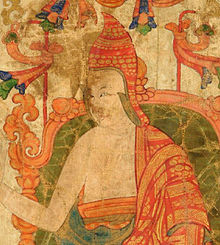|
Charyapada
 The Charyapada are a collection of mystical poems, songs of realization in the Vajrayana tradition of Buddhism from the tantric tradition in Assam, Bengal, Bihar and Odisha.[1][2]
It was written between the 8th and 12th centuries in various Abahattas that were ancestral to the modern Assamese, Bengali, Bhojpuri, Odia, Magahi, Maithili, Kurmali and many other Eastern Indo-Aryan languages[citation needed]. A palm-leaf manuscript of the Charyāpada was rediscovered in the early 20th century by Haraprasad Shastri at the Nepal Royal Court Library.[3] The Charyapada was also preserved in the Tibetan Buddhist canon.[4] Manuscripts The original palm-leaf manuscript of the Charyapada, or Caryācaryāviniścaya, spanning 47 padas (verses) along with a Sanskrit commentary, was edited by Shastri and published from Bangiya Sahitya Parishad as a part of his Hajar Bacharer Purano Bangala Bhasay Bauddhagan O Doha (Buddhist Songs and Couplets) in 1916 under the name of Charyacharyavinishchayah. This manuscript is presently preserved at the National Archives of Nepal. Prabodhchandra Bagchi later published a manuscript of a Tibetan translation containing 50 verses.[5] The Tibetan translation provided additional information, including that the Sanskrit commentary in the manuscript, known as Charyagiti-koshavrtti, was written by Munidatta. It also mentions that the original text was translated by Shilachari and its commentary by Munidatta was translated by Chandrakirti or Kirtichandra.[6] PoetsThe poets and their works as mentioned in the text are as follows:  
The manuscript of the Charyapada discovered by Haraprasad Shastri from Nepal consists of 47 padas (verses). The title-page, the colophon, and pages 36, 37, 38, 39, and 66 (containing padas 24, 25, and 48 and their commentary) were missing in this manuscript. The 47 verses of this manuscript were composed by 22 of the Mahasiddhas (750 and 1150 CE), or Siddhacharyas, whose names are mentioned at the beginning of each pada (except the first pada). Some parts of the manuscripts are lost; however, in the Tibetan Buddhist Canon, a translation of 50 padas is found, which includes padas 24, 25, and 48, and the complete pada 23. Pada 25 was written by the Siddhacharya poet Tantripāda, whose work was previously missing. In his commentary on pada 10, Munidatta mentions the name of another Siddhacharya poet, Ladidombipāda, but no pada written by him has been discovered so far.[citation needed]   The names of the Siddhacharyas in Sanskrit (or its Tibetan language equivalent), and the raga in which the verse was to be sung, are given prior to each pada. The Sanskrit names of the Siddhacharya poets were likely assigned to each pada by the commentator Munidatta.[citation needed]  PeriodHaraprasad Shastri, who rediscovered the Charyapada, conjectured that it was written during the 10th century. However, according to Suniti Kumar Chatterji, it was composed between 10th and 12th century. Prabodh Chandra Bagchi upholds this view. Sukumar Sen, while supporting this view, also states that the Charyapada could have been written between the 11th and 14th centuries.[7] However, Muhammad Shahidullah was of the opinion that the Charyapada dates back to an even earlier time. He maintained that it was likely to have been composed between 7th and 11th century.[8] Rahul Sankrityayan thought that the Charyapada was probably written between 8th and 11th century. LanguageHaraprasad Shastri, in his introduction to the Charyacharya-vinishchaya, referred to the enigmatic language of its verses as "twilight language" (Sanskrit: Sandhya-bhasha), or Alo-andhari (half-expressed and half-concealed) based on the Sanskrit commentary of Munidatta. Vidhushekhara Shastri, on the basis of evidence from a number of Buddhist texts, later referred to this language as 'Intentional Language' (Sanskrit: Sandha-bhasha).[9] The padas were written by poets from different regions, and it is natural that they would display linguistic affinities from these regions. Different scholars have noted the affinities of the language of the Charyapada with Assamese, Odia, Bengali, and Maithili.[10] Affinities with AssameseLuipa was from Kamarupa and wrote two charyas. Sarahapa, another poet, is said to have been from Rani, a place close to present-day Guwahati. Some of the affinities with Assamese are:[11] Negatives – the negative particle in Assamese comes ahead of the verb: na jãi (No. 2, 15, 20, 29); na jivami (No. 4); na chadaa, na jani, na disaa (No. 6). Charya 15 has 9 such forms. The vocabulary of the Charyapadas includes non-tatsama words which are typically Assamese, such as dala (1), thira kari (3, 38), tai (4), uju (15), caka (14) etc. Affinities with BengaliA large number of the Siddhacharyas who wrote the verses of Charyapada were from Bengal.[12] The affinities with Bengali language are:[13] Genitive -era, -ara; Ekaso (100), Padama (Padma:Lotus), Chausatthi (64), Pakhudi (petals) Tahin (there, in that), Charhi (climb/rise), nachai (dances), Dombi (a Bengali woman belonging to the scheduled caste, Domi/Domni), Bapuri (a Bengali word for 'poor fellow'; 'বাপুর, বাপুড়া'[14]) Affinities with Bihari languagesSeveral scholars have noted the affinities of the Charyapadas with Bihari languages like Maithili, Magahi and Bhojpuri. Rahul Sankrityayan in his Puratatv Nibandhawali noted that most of the Siddhas who composed the poems were from Bihar and the language used was an early form of Magahi. The historian, K. P. Jayaswal deemed the Charyapada poems to be an early form of Maithili.[15] Affinities with OdiaThe beginnings of Odia poetry coincide with the development of Charya Sahitya, the literature thus started by Mahayana Buddhist poets.[16] RāgaBefore each song in the manuscript, a Rāga is given to which it is to be sung. The complete set of rāga used in the Charyapada is list below.
While some of these Rāgas are extinct, the names of some of these Rāgas may actually be variant names of popular Rāgas we know today.[17] References
Further reading
External linksWikimedia Commons has media related to Charyapada. |
